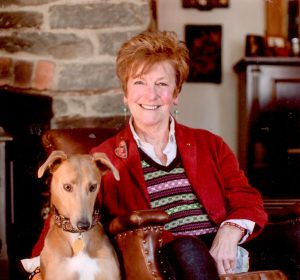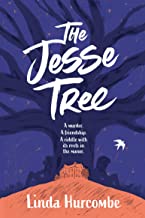The Longest Legs in Literature? Thirty Years to a Debut Novel
 by Linda Hurcombe
by Linda Hurcombe
I cannot claim with candour that writing was my one and only childhood aspiration, and a school incident when I was six might well have discouraged a less persistent child. Miss Petrie, my first grade teacher, asked us to write a poem about our favourite animal; mine is a sharply etched memory:
I had a little pony
she was silky black and white,
she was very very gentle
and would never snap or bite.
We would run through the wilderness
and across the open fields
and I would never sell my pony
for all the ponies in the world.
Miss Petrie was good at frowning, especially at me, always over-eager about EVERYTHING. She handed my poem back. There, in red ink with a frowny face next to my drawing of me hugging my imaginary spotted pony, she had written, IS THIS YOUR WORK??? ?
“It’s wrong to copy someone else’s poem. This looks like plagiarism.”
Play-jer-isum. It sounded like a not-fun game. Miss Petrie wrote the word on my poem’s page with another question mark, and told a now shamefaced me to take the poem home and ask my parents about it.
“What is play-jer-isum, Mom?”
“Plagiarism: dictionary definition ‘from Latin: a kidnapper … the practice of taking someone else’s work or ideas and passing them off as one’s own.’ Your teacher probably thought you’d copied the Mother Goose rhyme about a mean rich lady who whipped a dapple grey pony. Your poem has the same rhythm and first line, but the meaning is different.”
It was an early lesson in the fine line between inspiration and imitation, yet to this day I am haunted by the goblin of unconsciously ‘lifting’ the work of others.
This year, decades away from Miss Petrie’s classroom, I became a “debut author” in my seventies, with my teen novel The Jesse Tree. In fact, I was not put off writing for so long, as my first published work was in journalism and non-fiction.
In fairness, my six-year-old self’s future was to be filled with brilliant teachers who encouraged my writing, and I since have enjoyed a long and fulfilling career playing with words, including as a teacher myself at times. I’m not the sort of writer to think any form is superior and anyhow never stopped writing fiction for my kids and myself, because you can just let rip and play god.
It’s an irresistible temptation to work out what it’s like to be other people — to put it grandly, to stand in the shoes of someone who isn’t me and be in charge of how they live the story of their lives. I want always to be me, but also want to get under other people’s skin; to understand what it’s like to be not me.
The Jesse Tree’s journey to publication was a long and bendy road. Its original inspiration owes a great deal to a notorious and still unsolved murder committed in Shropshire, England in the late 1980s. Living nearby, I was intrigued by the investigation and a friend and I unsuccessfully pitched the story for a television documentary.
Failure being a great catalyst, I decided the tale would fare better as fiction. I remember the great whoosh! of release I felt, and from this, the characters and story sprang to life.
I’d written two previous novels, the first withdrawn by agreement with my agent after 18 rejections. The Jesse Tree did not get rejected, indeed it did not even get a chance as my circumstances changed suddenly and devastatingly. Following the death of my teenage daughter, Caitlin, and subsequently the sudden and early death of a superb editor and mentor at a childrens’ publisher, I felt cursed and abandoned The Jesse Tree for many years.
I threw myself into writing books on grief and depression, subjects I felt compelled to explore. I put my writerly energy into working as commissioning editor at a London publisher, and my personal ambitions into establishing a local charity in my daughter’s memory, Caitlin’s Kickstart Award, gifting money to teenagers to pursue their dreams in further/higher education.
Serendipity and timing play an important part in our lives. In my case it was an editor friend at Penguin Random House in New York who most encouraged me to re-visit the ‘timeless tale’ in The Jesse Tree and ‘get that story out there’. I was on the cusp of sending the book over the pond when I discovered Orphans Publishing, who ticked all the boxes for me (local! independent! top quality!) and who said yes to The Jesse Tree and my teenage characters the inquistive Robin Swallow and her new friend, Romany Gypsy Summer Locke.
The idea of adopting a ‘teen voice’ came naturally, but the original version was written in the third person. An untested theory about educators is that we tend to settle our attitudes at roughly the chronological age of our students, our demon/angel alter egos. Every year we grow older, and our students stay the same age. It’s just taken 30 years for my characters to find their voices in the outside world.
So. Having spent half my life writing The Jesse Tree, I say to women writers of all ages that determination, talent and a great deal of luck are unstoppable. Go for it!
——————————-
About the Book
 THE JESSE TREE
THE JESSE TREE
‘Now,’ said Summer Locke, ‘you stare me in the eye to the count of one hundred, no blinking allowed, and we shall be kin and I shall show you magic.’
Robin Swallow used to live in the heart of a city full of life. Now her mother’s moved them all to the back of beyond, a sleepy rural backwater where nothing ever happens.
Well, apart from the murder at the manor house. Oh, and the mysterious face at Robin’s window one night.
Robin has an independent streak a mile wide and a nose for a mystery. A mystery to which Summer Locke, Romany Gypsy, holds the key . . .
About the Author
Linda Hurcombe was born in Detroit Michigan, North America, but in the present political climate she’s inclined to say she is Canadian. Teacher, freelance journalist, editor and academic, Linda has raised and treasured two children. Her daughter died in 1998 aged 19 and a charity, Caitlin’s Kickstart Award, is established in her memory. THE JESSE TREE is Linda’s first novel at an age when she is “old enough to know better but too young to refuse writing a good story.” Passionate about young people and the potential of youth, Linda remains a spiritual teenager to the present day. Further maturity is highly unlikely. She is presently working on her next book, Bedtime Stories for Dogs.
www.caitlinskickstartaward.org.uk
Twitter: @LindaHurcombe
Links to buy:
Amazon UK: http://tiny.cc/sql9fz
Orphans Publishing: http://tiny.cc/qpl9fz
Wordery: http://tiny.cc/qnl9fz
About Orphans Publishing
Orphans Publishing are an independent, family-run publisher. As a small publisher with big ambitions, they care about every comma, peruse every Pantone chart and paper option, and craft creative publicity and marketing opportunities so their books stand out from the crowd.
Twitter: @orphanspublish
Category: Contemporary Women Writers, How To and Tips
























